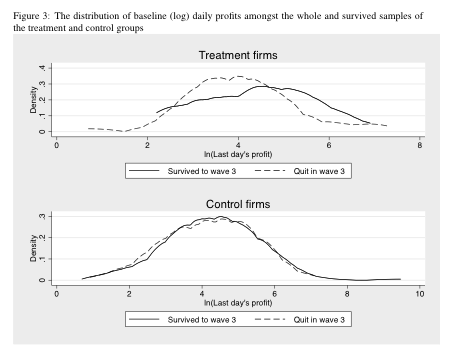What makes an entrepreneur successful? Is it enough to be motivated to run your own business? Or does one require certain skills to be a successful businesswoman? If yes, can these skills be learned? The literature has documented that in developing countries firms are often run inefficiently. Given that 45% of the labor force in lower income countries are self-employed, non-agricultural workers, and private sector growth plays a crucial role as a job creator, it is of utter importance to understand both how business decisions are made and whether poor decisions are caused by a lack of business literacy.
Gabriela Calderón, Jesse M. Cunha, and Giacomo De Giorgi conducted a randomized controlled trial by providing business training to small and micro female entrepreneurs in the poor, rural Mexican state of Zacatecas and analyze the effects in their recent Barcelona Graduate School of Economics Working Paper (No. 742), “Business Literacy and Development: Evidence From a Randomized Controlled Trial in Rural Mexico”.
Who and what was taught?
Partnering with the NGO CREA a random group of the 900 female entrepreneurs, who make and sell food, make craft items, or sell consumer goods in small shops, were offered a free, 48-hour business training course. CREA offered participants, of which the majority had low levels of formal education, small incentives to attend the course consisting of six topics:
- understanding the difference between unit, marginal, fixed, and total costs
- optimal price setting in order to maximize profits
- basic legal rights and obligations, such as formally registering a business
- choice of products to produce or sell
- marketing
- how to be an effective salesperson
The idea was to find out whether this could be a cost effective way to improve the entrepreneur’s performance.
The entrepreneurs practiced what was preached
In addition to the survey before the training, two waves of data were collected afterwards, approximately 18 months apart, which allows analyzing longer run impacts and increases the statistical power of the estimation. The effect of the training is estimated to have significantly increased last day’s profits by about one fourth. Access to business literacy classes seems to have increased revenues and the number of clients served. An important finding is that the effects are not short-lived; they are of similar magnitude in both the short run (one year after the intervention) and the medium run (2.5 years post intervention) suggesting long lasting positive effects. The observed increase in profits appears to stem from reduced costs rather than increased prices. Program invitees seem to be changing what kind of goods they sell, suggesting that entrepreneurs dropped goods with low profits, revenues, and prices; kept goods with high profits and revenues and low costs; and added goods with high revenues and low costs. This indicates that participants understood and made use of the pricing and choice of product concepts they had been taught. In addition the offer of classes significantly increased the share of entrepreneurs using formal accounting practices from one percent to 5.7 percent. The number of hours worked per week increased insignificantly by 2.6 hours but the size of the enterprise appears to be unaffected. Finally, invitees are 8.6 percentage points more likely to register their business with a government agency, which is important for tax collection and therefore the public good.
Results suggest small spillover effects
Looking at spillover effects, the authors find that profits decreased by 11% for entrepreneurs that did not receive the training in villages where others did, compared to villages where nobody received training. These entrepreneurs might have suffered in terms of profits, but they do seem to have learned something from their competitors, as the share using formal accounting methods increased by 5.7 percentage points.
The theoretical channel
The authors build a theoretical model in the spirit of Karlan, Knight, and Udry (2012) providing two main empirical predictions. First, entrepreneurs of lower ability should be more likely to quit their businesses upon trying the new management technologies taught in class. The intuition is that by trying new technologies induced by the teachings, the least able learn that they are not meant to be entrepreneurs. In the data those below the median of pre-treatment profits are 1.9 percentage points more likely to quit while those above the median are 4.8 percentage points less likely to do so, and as can be seen in the Figure below, the effects on quitting are quite substantial for the very low pre-treatment profit entrepreneurs. Second, there should be a positive effect of the training on profits, for skilled entrepreneurs, for which the authors provide empirical support, in fact the large positive effects on profits are found on those entrepreneurs with pre-training profits above the median.

A cost-effective measure
A large literature has looked at the effects of microfinance, but rarely of basic business training in isolation. In this research project the training is nearly twice in length compared to most recent studies lasting six weeks with two, four-hour classes per week totaling 48 hours. Given that microcredit does not seem to provide compelling evidence of true transformative power, an alternative option of how to improve outcomes in developing countries cost-effectively is an important research topic. Indicated by a back-of-the-envelope approximation, the provision of business literacy can be a cost-effective measure to improve outcomes for entrepreneurs.
References
Karlan, D., Knight, R., & Udry, C. (2012). Hoping to win, expected to lose: Theory and lessons on micro enterprise development (No. w18325). National Bureau of Economic Research.
photo credit: Mujer tejiendo by Lorena Pajares cc



